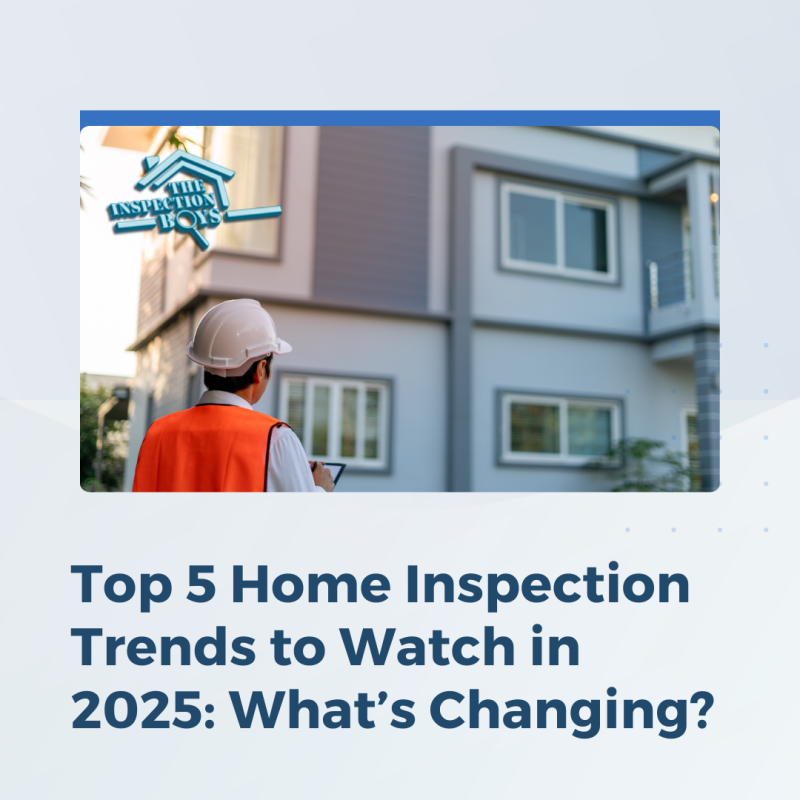The home inspection industry is evolving, adapting to modern technologies, environmental concerns, and the growing need for more precise and specialized services. As we move into 2025, home inspections are more than just a routine step in the buying process; they are essential tools for ensuring safety, sustainability, and peace of mind. Here, we explore the top five trends in home inspection services, offering insights into what buyers, sellers, and industry professionals can expect in the coming year.
The Shift to Smart Home Inspections
As homes become more connected and tech-savvy, smart home inspections are becoming a necessity. Home inspectors are now required to understand and assess various smart home systems, including automated lighting, heating, security, and even energy management systems. This shift is transforming the traditional inspection process, as inspectors need to be tech-aware and capable of evaluating not only structural elements but also complex digital systems.
Why Smart Home Inspections Matter
Smart homes are equipped with devices that range from simple conveniences to essential security and energy-saving tools. Inspectors are increasingly called upon to verify that these devices are properly installed, secure, and functional. An inspection that misses key aspects of a home’s technology can lead to costly repairs and even safety risks for homeowners. By 2025, it will be standard for home inspection services to include an evaluation of smart home devices, making tech-savvy inspectors more valuable than ever.
Focus on Environmental and Climate-Resilient Inspections
With environmental challenges and extreme weather events becoming more common, climate-resilient home inspections are gaining momentum. Home inspectors are now looking beyond structural integrity and safety to include an assessment of a property’s environmental resilience. For homes in flood-prone areas, for instance, inspections are incorporating checks for water damage mitigation measures, such as flood barriers and sump pumps.
Adapting to Changing Climate Needs
In areas prone to wildfires, floods, or severe storms, inspectors are trained to assess how well a home can withstand these natural events. This includes examining landscaping choices, roofing materials, drainage systems, and fire-resistant features. Such evaluations provide valuable insights into the home’s durability in various climates and can be critical for buyers and sellers in specific regions. The added attention to climate resilience is making home inspections more comprehensive and tailored to individual geographic areas.
Advanced Tools and Technology: Drones and Thermal Imaging
Home inspections today are far more advanced than they were even a decade ago, with inspectors now leveraging high-tech tools like drones and thermal imaging cameras. Drones are particularly useful for inspecting rooftops, chimneys, and other hard-to-reach areas, enabling inspectors to identify potential issues safely and efficiently.
The Role of Drones and Thermal Imaging
Thermal imaging, on the other hand, allows inspectors to detect problems such as poor insulation, electrical issues, and water damage that are invisible to the naked eye. By using these tools, inspectors can deliver a more accurate assessment, helping buyers make informed decisions. In 2025, we expect even more home inspection services to adopt these advanced tools as part of their standard practices, ultimately raising the bar for inspection quality.
Sustainable and Eco-Friendly Home Inspections
As sustainability becomes a priority for homeowners, eco-friendly home inspections are on the rise. These inspections focus on evaluating a home’s environmental impact and energy efficiency, appealing to buyers who are keen to lower their carbon footprint and utility costs. Inspectors now often assess everything from a home’s insulation and heating system efficiency to the materials used in construction and remodeling.
What Makes an Eco-Friendly Inspection?
An eco-friendly inspection provides an analysis of the home’s energy consumption, water usage, and waste management systems. For example, inspectors may assess windows, doors, and HVAC systems to identify potential areas for energy-saving improvements. Additionally, they might examine solar panel installations or rainwater collection systems, offering insights into their functionality and benefits. Eco-friendly inspections are quickly becoming popular with a growing number of environmentally conscious buyers, making this trend one to watch in 2025.
Emphasis on Specialized Inspections
Lastly, 2025 is expected to see a growth in specialized home inspections, tailored to meet the unique needs of specific homes and buyers. Traditional inspections may no longer cover every detail that buyers are interested in. In response, the industry is expanding to include a variety of specialized inspections, such as radon testing, pest inspections, mold assessments, and even inspections specific to historic properties.
Why Specialized Inspections Are Important
Different types of homes and environments have different inspection needs. For instance, older homes may require additional checks for lead paint or asbestos, while properties in rural areas may benefit from well water testing and septic system inspections. This specialization allows inspectors to provide more value and precision in their reports. Buyers and sellers alike are finding these tailored inspections helpful in identifying specific issues and improving transparency during the sale process.
The Future of Home Inspections
As the home inspection industry adapts to these new trends, it is clear that inspections are becoming more thorough, efficient, and adaptable. Home inspectors who embrace technology, environmental awareness, and specialized skills will find themselves ahead of the curve, offering essential services in an ever-evolving market.
Whether you’re a buyer looking for peace of mind or a seller aiming to showcase your property’s strengths, staying informed on these home inspection trends will be beneficial in 2025 and beyond.

